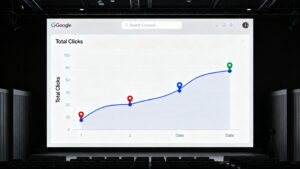Table of Contents
Toggle1. Define Goals and Audience for a B2B Foundation
The entire strategy must align with your broader B2B objectives (a key component of Primary Position’s “Digital Strategy Development”).
-
Solve Problems: B2B buyers use YouTube to find solutions to complex problems. Your primary goal is to establish thought leadership and trust by addressing their challenges.
-
Target the Funnel: Create strategic content categories (playlists) that address every stage of the B2B buyer’s journey:
-
Awareness: Educational videos, industry trends, and thought leadership.
-
Acquisition/Consideration: “How-to” guides, tutorials, and comparisons.
-
Revenue/Conversion: Product demos, case studies, customer testimonials, and deep-dive webinars.
-
2. Maximize Search Visibility (The SEO Core)
The single most critical step is optimizing your videos for both YouTube Search and Google Search, treating video content as a tool for organic lead generation.
| Component | Strategy |
| Keyword Strategy | Conduct thorough B2B keyword research. Focus on long-tail, problem-solving queries (e.g., “How to solve X in 9 minutes,” “preventing Y problem”) rather than just product names. |
| Optimization | Use keywords naturally in the Title, the first 1-2 sentences of the Description, and your tags. Create detailed, keyword-rich descriptions that function like a mini-blog post. |
| Content Quality | Focus on being informative and accurate, not just “entertaining.” High-quality production value builds credibility with B2B decision-makers. |
| Video Format | Utilize relevant formats like Explainer videos, Product Demos, and Customer Testimonials—these are what B2B buyers are actively searching for. |
3. Cross-Platform Integration (The Digital Strategy)
Per the principle of maximizing each platform individually while ensuring an end-to-end strategy, your YouTube content must be leveraged across your other marketing channels.
-
Website & Blog: Embed YouTube videos within relevant blog posts and product pages to boost on-page SEO and increase viewer retention.
-
Email Marketing: Use video thumbnails and links in email campaigns to increase click-through rates and drive traffic to your YouTube channel.
-
Paid Advertising (PPC): Utilize YouTube Advertising (skippable, non-skippable, bumper ads) to promote your high-value lead magnets (demos, webinars) to precisely targeted demographics and interests, complementing your Google Ads (PPC) strategy.
-
Social Media: Promote videos and snippets across LinkedIn, Twitter/X, and other B2B platforms, ensuring the views are driven back to the original YouTube video to build channel authority.
4. Consistency and Conversion
-
Consistent Schedule: Maintain a feasible, reliable content calendar (e.g., one video per week). Consistency builds audience expectation and helps the YouTube algorithm favor your channel.
-
Engage & Nurture: Actively respond to comments and questions to foster a community and build trust. Use interactive elements (polls, Live Q&As) to move subscribers toward a 1-to-1 relationship.
-
Clear Calls-to-Action (CTAs): Every video must have a clear purpose and direct the viewer to the next step in the conversion funnel, whether it’s downloading a whitepaper, registering for a demo, or visiting a specific landing page on your website.




